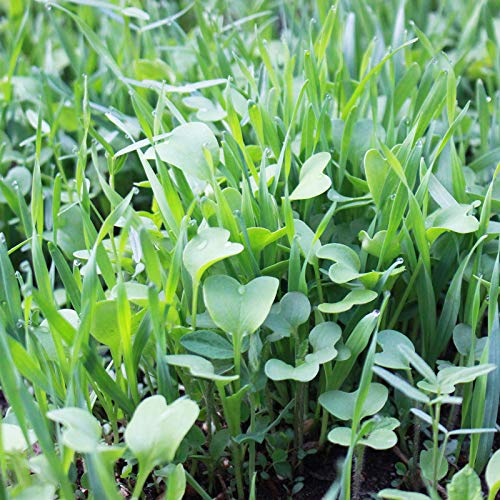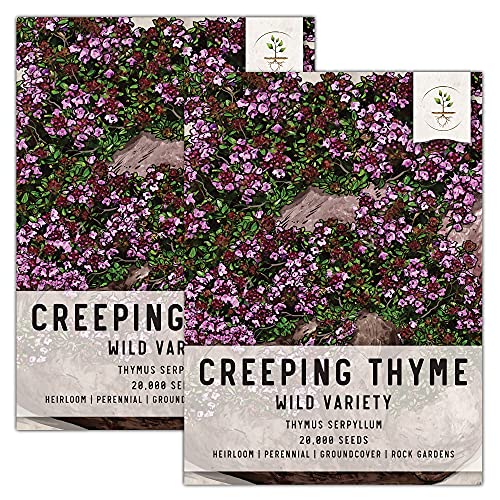If you’re looking for a low-maintenance landscaping solution for the area around your foundation, ground cover might be just what you need. Not only does it help prevent soil erosion and control weeds, but it also adds a pleasing aesthetic touch to your property. However, with so many options available, it can be difficult to determine which type of ground cover is the best choice for your needs.
Before making a purchase, there are a few factors to consider. First, think about the climate in your area and whether the ground cover can handle the conditions. Second, consider the amount of sun or shade the area receives and select a ground cover that thrives in those conditions. Finally, think about the layout of your property and the overall style you want to achieve, as certain ground covers work better in different settings.
When it comes to selecting the best ground cover for next to your foundation, questions might come up – what are the most popular options? What are the benefits of each? Are there any drawbacks to consider? How can you care for it once it’s installed? How much does it cost? In this article, we’ll answer all these questions to help you make an informed decision on the best ground cover for your needs.
10 Best Ground Cover Next To Foundation
| # | Product Image | Product Name | Product Notes | Check Price |
|---|---|---|---|---|
|
1
|
Ideal for attracting pollinators, including bees, butterflies, and hummingbirds. Easy to grow and maintain in a container garden.
|
|
||
|
2
|
Ideal for creating a low-maintenance, drought-resistant lawn and ground cover that promotes soil health and attracts pollinators.
|
|
||
|
3
|
Ideal for ground cover and landscaping; fully rooted Asiatic Jasmine Minima with soil included, ready to plant.
|
|
||
|
4
|
Ideal for ground cover in shaded areas with evergreen foliage.
|
|
||
|
5
|
This product is ideal for those looking for a low ground cover plant and lawn alternative in warm seasons.
|
|
||
|
6
|
Ideal for landscaping and ground cover, with approximately 8000 seeds to ensure ample coverage.
|
|
||
|
7
|
The product is ideal for erosion control, ground cover, lawn alternative, pasture, and forage purposes.
|
|
||
|
8
|
This product is ideal for mulching and creating a weed barrier in garden beds and landscaping.
|
|
||
|
9
|
This product is ideal for improving soil health and fertility by planting a blend of cover crop seeds.
|
|
||
|
10
|
This product is ideal for planting wild creeping thyme seeds, which are heirloom and open pollinated.
|
|
1. Wildlife Haven: 1lb Perennial Wildflower Seed Mix
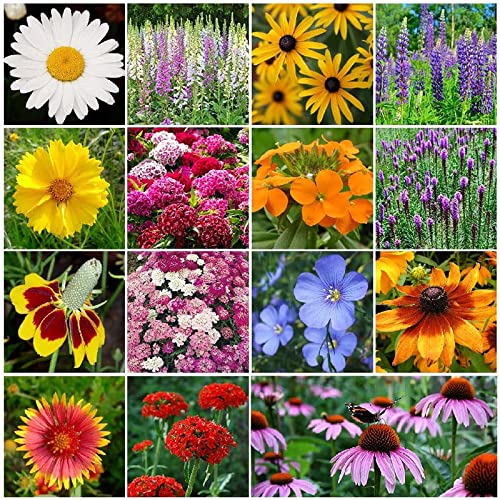
The All Perennial Wildflower Seed Mix is a must-have for garden enthusiasts who are looking to add a vibrant and diverse range of flowers to their outdoor space with minimal effort. This popular mix includes some of the most beloved perennial wildflower varieties, such as blue flax, perennial lupine, Mexican hat, gloriosa daisy, black-eyed Susan, candytuft, gayfeather/blazing star, Maltese cross, and seven more stunning varieties.
Not only does this mix add a pop of color to any garden, but it also attracts hummingbirds and pollinators, making it a valuable addition to any outdoor space. Whether you have a small garden or a large meadow, this seed mix is easy to plant and maintain, requiring very little attention from the gardener.
Growing wildflowers from seed has never been easier. Simply plant the seeds in the spring or fall and watch as they bloom in the second growing season. With colors ranging from red to purple and all shades in between, the flowers are sure to make any outdoor space look like a scene from a movie.
This mix thrives in full sun and can be planted in all North American zones. To ensure healthy growth, water the flowers when the soil is dry and cut off dead flowers to encourage growth.
Eden Brothers, a trusted name in the seed industry, offers the highest quality annual wildflower seed mixes and over 2,000 other varieties of flower, vegetable, and herb seeds and flower bulbs. The All Perennial Wildflower Seed Mix is 100% perennial and includes Siberian wallflower, Shasta daisy, lance-leaf coreopsis, sweet William, foxglove, purple coneflower, blanket flower, blue flax, perennial lupine, Mexican hat, gloriosa daisy, black-eyed Susan, candytuft, gayfeather/blazing star, and Maltese cross.
With their easy-to-grow nature and stunning colors, the All Perennial Wildflower Seed Mix is a top choice for any gardener looking to add a touch of natural beauty to their outdoor space.
2. Outsidepride Perennial White Miniclover Lawn Clover & Ground Cover Seeds – 5 Lbs, Green
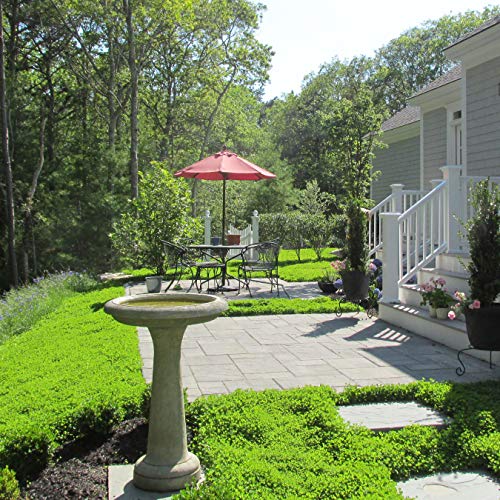
Looking for a natural fertilizer to mix with your current lawn? Look no further than Miniclover – the perfect lawn alternative! This trifolium repens seed only grows to about 4-6 inches tall after a few mows, making it much shorter than other white clovers used for lawns.
What sets Miniclover apart from other clovers is its size and leaf heads. Compared to white Dutch clover, Miniclover only gets half as tall and the leaf heads are only 1/3rd to 1/2 as large. This makes it ideal for those who want a no-mow lawn that still looks lush and green.
But Miniclover is not just for lawns. Many people also use this dwarf white clover as a ground cover when looking for an alternative to traditional grass. And because clover fixes nitrogen from the air, it acts as a natural fertilizer for your lawn or ground cover.
One of the best things about Miniclover is its versatility. You can grow this seed in USDA Zones 3 – 10 as a perennial, meaning it will come back year after year. And with a recommended sowing rate of 1-2 pounds per 1,000 square feet, you'll have plenty of Miniclover to cover your desired area.
3. Asiatic Jasmine Minima – 60 Live Plants – Asian Ground Cover Fully Rooted With Soil
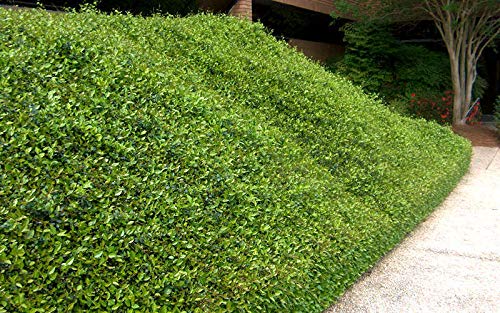
Florida Foliage exclusively grows, packages, and ships the evergreen and vine-like woody plant, Asiatic Jasmine. This plant is highly valued in landscapes due to its low maintenance requirements, hardiness, drought tolerance, and versatility. Originally native to Japan and Korea, Trachelospermum asiaticum is an ideal groundcover for those who want an attractive garden without putting in too much effort. It is often used for mass plantings and as an alternative to turfgrass, especially in shady areas where it provides much-needed texture and variation.
Asiatic Jasmine thrives in a variety of growing conditions and is known for its weed-suppressing qualities. Once established, it requires minimal maintenance to keep it looking nice, making it an excellent choice for low-maintenance landscapes. While it requires little mowing, occasional trimming of the edges is recommended. It is best suited for low traffic areas, as it does not tolerate foot traffic well. Neglecting this plant actually makes it easier to control. Overwatering, excessive sun exposure, or too much fertilizer can make it aggressive and unruly.
This plant is salt-tolerant, making it suitable for coastal areas. It is also a versatile plant that can be grown in containers and hanging baskets. Overall, Asiatic Jasmine is an attractive and low-maintenance option for those who want to enhance their landscape without putting in too much effort.
4. Dwarf Mondo Grass Qty 80 Live Plants Shade Loving Evergreen Ground Cover Ophiopogon Japonicus Nanus
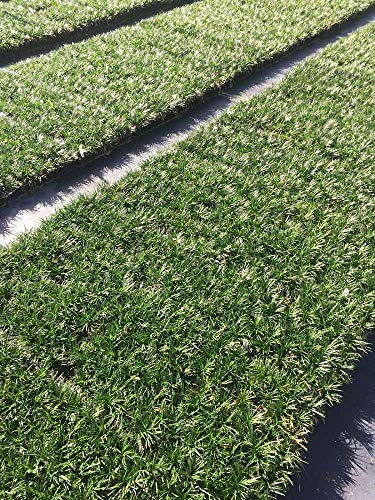
The dwarf mondo grass is a remarkable evergreen ornamental grass that boasts dense, dark green foliage, and a slow, clumping growth habit. Standing at only 4-6 inches tall and 4-6 inches wide, this grass is perfect as an edging plant or as a striking contrast when tucked into rocks. Mass plantings of this lush groundcover in the landscape are sure to impress.
This perennial evergreen grass is versatile and can be widely used in rock gardens, seashore plantings, borders, and as groundcover. Its low-maintenance nature makes it an excellent choice for those who want a beautiful garden without the hassle of constant upkeep. However, to ensure the growth of a mature root system, regular watering is necessary. Once established, watering is only needed occasionally, except during drought conditions where regular watering is required. Pruning old foliage is recommended to maintain a well-groomed appearance.
The dwarf mondo grass is often compared to a ground cover commonly known as Lilyturf (Liriope muscari). However, it has thinner leaves and a finer texture, giving it a unique and distinctive appearance.
5. Dwarf Perennial Dichondra: Low Maintenance Lawn Alternative
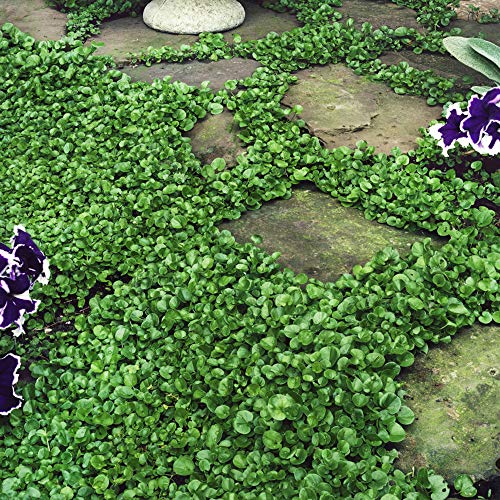
Dichondra Repens, also known as Kidney Weed, Dichondra Pony Foot, or Lawn Leaf, is a perennial ground cover plant that is very easy to establish from seed. It has a prostrate or creeping growth habit with broad, almost circular leaves, resembling clover. This warm-season, fast-growing plant grows very close to the ground and reaches a maximum height of only 2-3 inches. It is adapted to warmer climates, but can retain its striking green color during winter temperatures as low as 20-25 degrees Fahrenheit with only slight leaf browning.
Dichondra Repens is a great lawn alternative as it never needs mowed, making it a low-maintenance option for landscaping areas. When mowed low, it establishes a thick, dense carpet look, perfect for a ground cover situation where normal grasses may not do as well. It has a bright green color and feels very good underfoot. It is commonly used in landscaping areas of no maintenance where adapted.
For those who choose to use Dichondra Repens as a lawn alternative, it can be mowed for an even, smooth finish. Mowing every two weeks during the summer months at a height of 1 1/2" – 2" is recommended for the nicest appearance. During the winter months, it can be mowed as low as 3/4".
Dichondra Repens is a versatile plant that can be used in many ground cover situations. It is a great option for those who want a low-maintenance, attractive lawn alternative. The plant's circular leaves and dense growth pattern create a beautiful, uniform appearance. With its easy establishment from seed, Dichondra Repens is a great option for those who want a beautiful, low-maintenance lawn.
6. Purple Blaze Ground Cover Seeds – 8000 Count
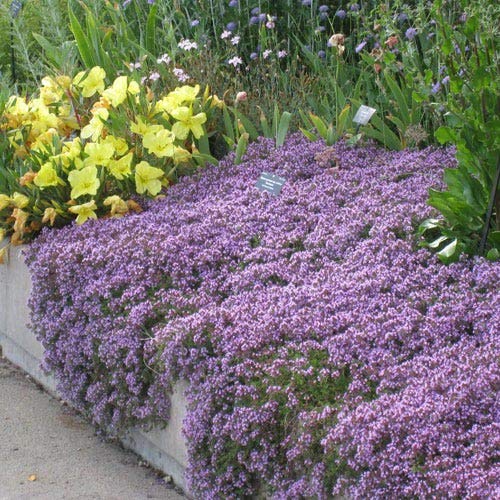
Potential customers should be aware that only Utopia Seeds can guarantee that they will receive the correct type of Thyme seeds. Creeping Thyme, also called Thymus Serpyllum, is a popular dwarf ground cover that is versatile and can be used for various landscape designs. It is a great choice for creating borders on flower beds and for filling in between pavers on walkways. Moreover, it can handle moderate foot traffic without any issues.
As a perennial herb, Creeping Thyme will survive the winter months in zones 4-9. To plant the seeds, it is recommended to sow them directly outdoors between May and August when the temperature is consistently in the high 60s or above. If you want to divide established plantings, it is best to do so in March and April. Avoid fall plantings as they can lead to freeze damage.
When planting the seeds, it is important not to cover them with soil but to press them into the soil. This will ensure that the seeds have good soil contact, which will promote optimal germination rates. With the net weight of 0.05 oz, the package contains approximately 8,000 seeds, which can cover a large area. It is important to note that the seeds are small and come in a small packet.
Creeping Thyme is an excellent alternative to traditional lawns as it requires low maintenance and can thrive in various environments. By choosing Creeping Thyme, you are making an eco-friendly choice that will also add beauty to your landscaping.
7. Dutch White Clover: Versatile Erosion Control & Lawn Alternative
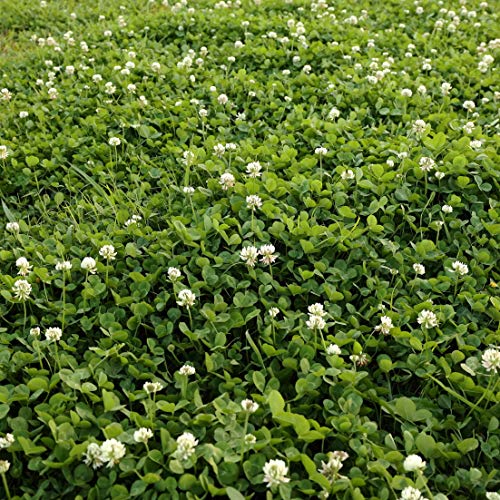
White Dutch Clover seed is a versatile perennial that can be used for a variety of purposes such as erosion control, ground cover, food plots, pasture mixtures, green manure crop and more. Its wide range of uses makes it an excellent choice for gardeners and farmers alike.
This seed can be grown in different parts of the country, from USDA Zones 3 to 10, making it a suitable choice for a variety of climates. It is often used for deer food plots, erosion control, pasture mixtures, and cover crops.
One of the great benefits of White Dutch Clover is its ability to increase soil nitrogen levels. It is capable of taking nitrogen from the air and fixing it into the soil, which is beneficial for plants. Additionally, it can be used as an alternative to traditional lawns.
To plant White Dutch Clover, simply broadcast the seed onto the prepared soil, and lightly rake it in. It is important to keep the seed moist until germination, which typically occurs within 14 days when temperatures range from 65 to 70F.
It is recommended to sow the seed at a rate of 1/4 lb to 1/2 lb per 1,000 square feet or 8 to 10 lbs per acre. This seeding rate ensures that the clover grows evenly and provides maximum coverage.
8. Hull Farm 50150 Cocoa Bean Shell Mulch, 2 Cubic Feet
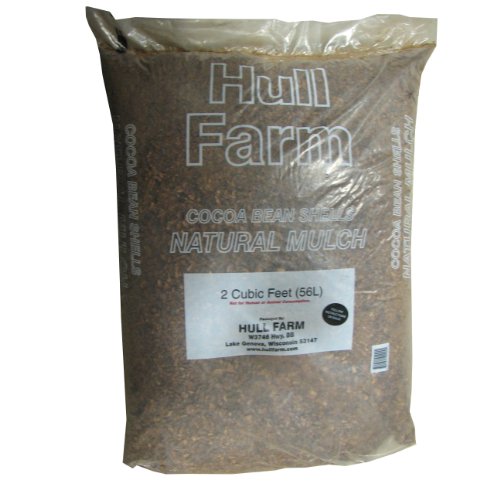
The cocoa shell mulch is an excellent choice for gardeners who want to nourish their plants without harming them. With a fertilizer value of 2.5-1-3, it is a wholly organic mulching material made from the outer shell of the cocoa bean. This mulch is a slow-breaking material that will not disappear into the soil, making it an ideal choice for those looking for long-lasting results.
This mulch can be applied in the spring or summer to help reduce weeds and conserve water. It is an effective way to protect your plants from heat stress and moisture loss, while also enriching the soil with essential nutrients. Unlike other mulching materials, cocoa shell mulch will not burn vegetation, making it a safe choice for any garden.
The cocoa shell mulch comes in a 2-cubic feet bag, providing ample coverage for your garden. It is easy to apply and will not require frequent reapplication, saving you time and money in the long run. Gardeners who want a sustainable and eco-friendly option will appreciate the natural and wholly organic nature of this mulch.
Best Ground Cover Next To Foundation FAQs
Are there any ground covers that can help deter pests and insects from entering my home?
Yes, there are several types of ground covers that can help deter pests and insects from entering your home. One popular option is mint, which has a strong scent that repels pests such as ants, spiders, and mosquitoes. Another option is marigolds, which contain a compound called pyrethrum that is toxic to many insects. Planting marigolds around the perimeter of your home can help keep pests at bay. Additionally, thyme and rosemary are both herbs that have natural insect-repelling properties and can be used as ground covers. Other options include pennyroyal, which repels fleas and ticks, and citronella grass, which is commonly used in candles and other products to repel mosquitoes. It's important to note that while these ground covers can be effective in deterring pests, they should not be relied upon as the only form of pest control.
Are there any ground covers that can help insulate my home and reduce energy costs?
Yes, there are a few ground covers that can help insulate your home and reduce energy costs. One such ground cover is creeping phlox. Its dense green foliage can help insulate your home by reducing heat loss through the ground. Another option is creeping thyme, which can help regulate soil temperatures and also has a fragrant scent. Another ground cover that can help reduce energy costs is moss. Moss is particularly effective at retaining moisture and can also help regulate soil temperatures. Additionally, a layer of mulch can also help insulate your home by reducing heat transfer through the ground. Overall, incorporating these ground covers into your landscaping can help reduce energy costs by providing natural insulation for your home.
Can I plant ground covers directly against a concrete foundation or do I need to create a barrier first?
It is not recommended to plant ground covers directly against a concrete foundation without creating a barrier first. This is because the soil and moisture can hold against the foundation, potentially causing damage or structural problems.
To create a barrier, you can install a layer of landscape fabric or plastic between the foundation and the soil. This will prevent the ground cover from growing directly against the foundation and allow for proper drainage.
Another option is to create a raised bed against the foundation and fill it with soil. This will provide a buffer between the foundation and ground cover while still allowing for planting.
It is important to consider the type of ground cover being planted as well. Some ground covers, such as ivy, can be aggressive and may cause damage to the foundation over time. It is best to consult with a professional landscaper or horticulturist for advice on the best ground cover options and installation methods for your specific situation.
How do I prepare the soil before planting ground cover near my foundation?
Before planting ground cover near your foundation, it's important to prepare the soil properly to ensure healthy growth. The first step is to remove any weeds, rocks, and debris from the area. Then, loosen the soil to a depth of about 6 inches using a garden fork or tiller. Next, add organic matter such as compost, aged manure, or leaf mold and mix it into the soil. This will improve soil structure, drainage, and fertility.
It's also important to test the soil pH and adjust it if necessary. Most ground covers prefer a pH range between 6.0 and 7.0. You can adjust the pH by adding lime to raise it or sulfur to lower it. Follow the instructions on the product label and mix it into the soil thoroughly.
Finally, add a layer of mulch to the soil surface to conserve moisture, suppress weeds, and regulate soil temperature. Organic mulches such as bark, wood chips, or straw work well for ground covers. Spread the mulch to a thickness of 2-3 inches, being careful not to cover the stems or leaves of the plants. With proper soil preparation, your ground cover should thrive and provide an attractive and practical addition to your landscape.
What are some of the factors I should consider when selecting a ground cover for a shady area next to my foundation?
Selecting the right ground cover for a shady area next to your foundation can be a challenging task. However, there are certain factors that you should consider before making your final decision. Firstly, you should consider the amount of shade the area receives. Some ground covers require partial shade, while others can thrive in full shade. Secondly, you should consider the soil type and drainage in the area. Some ground covers prefer well-drained soils, while others can tolerate moist soils. Thirdly, you should consider the height and spread of the ground cover. Some ground covers grow tall and spreading, while others remain low and compact. Fourthly, you should consider the maintenance requirements of the ground cover. Some require regular pruning and watering, while others can survive with little attention. Lastly, you should consider the aesthetic appeal of the ground cover. Choose a ground cover that complements the style and design of your home. By considering these factors, you can select the right ground cover that will thrive in a shady area next to your foundation.
What are the best ground cover options for planting next to a foundation?
When choosing ground cover options for planting next to a foundation, there are several factors to consider such as the amount of sunlight, water availability, soil type, and overall aesthetics. Some of the best ground cover options include creeping phlox, creeping juniper, sedum, and vinca minor.
Creeping phlox is a great option as it produces beautiful flowers and is low maintenance. This plant prefers well-drained soil and requires moderate watering. Creeping juniper is another excellent option as it adds a natural touch to the landscape and is resistant to pests and diseases. Sedum is perfect for sunny areas and requires little maintenance. This plant also attracts pollinators to the area. Vinca minor is a hardy plant that can thrive in both sun and shade. It is also a great option for erosion control.
Regardless of the option you choose, it's essential to ensure that the ground cover is not invasive and does not cause damage to the foundation. Additionally, it is advisable to consult with a professional landscaper to determine the best options for your specific needs and environment.
What is the best way to choose a ground cover that complements the look of my home's exterior?
When choosing a ground cover that complements the look of your home's exterior, it's important to consider a few key factors. First, take a look at the style and color scheme of your home's exterior. Is it traditional or modern? Do you have a lot of neutral tones or pops of color? This will help guide your choice of ground cover.
Next, consider the amount of sunlight and moisture in the area where you want to plant the ground cover. Some plants thrive in shade, while others need full sun. Some ground covers, like moss, prefer moist soil, while others, like succulents, prefer drier conditions.
Finally, think about the maintenance level you're comfortable with. Some ground covers, like grass, require regular mowing and watering, while others, like clover, are low-maintenance and even attract beneficial insects.
Ultimately, the best way to choose a ground cover that complements your home's exterior is to do your research, consult with a professional landscaper if needed, and consider your own personal preferences and lifestyle. With the right choice, your ground cover can enhance the beauty of your home's exterior for years to come.
What types of plants should I avoid planting near my foundation to prevent damage?
When it comes to planting near your foundation, it's important to choose the right types of plants to prevent any damage. Generally, it's best to avoid planting trees or shrubs with extensive root systems near your foundation. This is because the roots can grow under your foundation and cause it to shift or crack over time. Some examples of plants to avoid include willows, poplars, and silver maples.
In addition to avoiding plants with large root systems, it's also important to consider the proximity of the plant to your foundation. As a general rule, it's best to plant shrubs and other vegetation at least three feet away from your foundation to prevent any potential damage.
If you're looking for plants that are safe to plant near your foundation, there are a variety of options available. Some examples include low-growing ground covers, such as creeping thyme or sedum, as well as shallow-rooted plants like hostas or daylilies. Ultimately, the type of plant you choose will depend on your personal preferences and the specific needs of your property.
Which ground covers require the least amount of maintenance and upkeep?
Ground covers are a low-maintenance alternative to grass as they require less water, fertilizer, and mowing. Some of the most low-maintenance ground covers include creeping thyme, clover, and moss. Creeping thyme is a fragrant herb that spreads quickly, forming a dense mat that suppresses weeds. Clover is a nitrogen-fixing plant that enriches the soil and attracts pollinators. It grows well in poor soil and can tolerate drought conditions. Moss is a non-flowering plant that thrives in shady areas and moist soil. It requires no mowing or fertilization and adds a natural, organic look to the landscape.
Other low-maintenance ground covers include sedum, vinca, and creeping Jenny. Sedum is a drought-tolerant succulent that comes in a variety of colors and textures. Vinca is an evergreen perennial that grows well in sun or shade and produces attractive blue or purple flowers. Creeping Jenny is a fast-growing plant that spreads quickly, forming a bright green carpet that is perfect for filling in gaps between stepping stones or in rock gardens. Ultimately, the best low-maintenance ground cover will depend on the specific growing conditions and aesthetic preferences of your landscape.
Which type of ground cover is the most effective at preventing erosion near a foundation?
One of the most effective ground covers for preventing erosion near a foundation is mulch. Mulch is a layer of organic material that is spread over soil, and it provides numerous benefits. For one, mulch helps to retain moisture in the soil, which can prevent erosion caused by heavy rainfall. Additionally, mulch acts as a barrier between the soil and the sun, which can help to prevent soil from drying out and becoming brittle. Another benefit of mulch is that it can help to suppress weed growth, which can help to prevent soil from eroding due to the removal of plant roots. When choosing a type of mulch, it's important to consider factors such as the slope of the area, the amount of rainfall in the area, and the type of soil present. Some effective types of mulch include wood chips, straw, and bark. Ultimately, the best type of mulch will depend on the specific needs of your foundation and the surrounding landscape.

